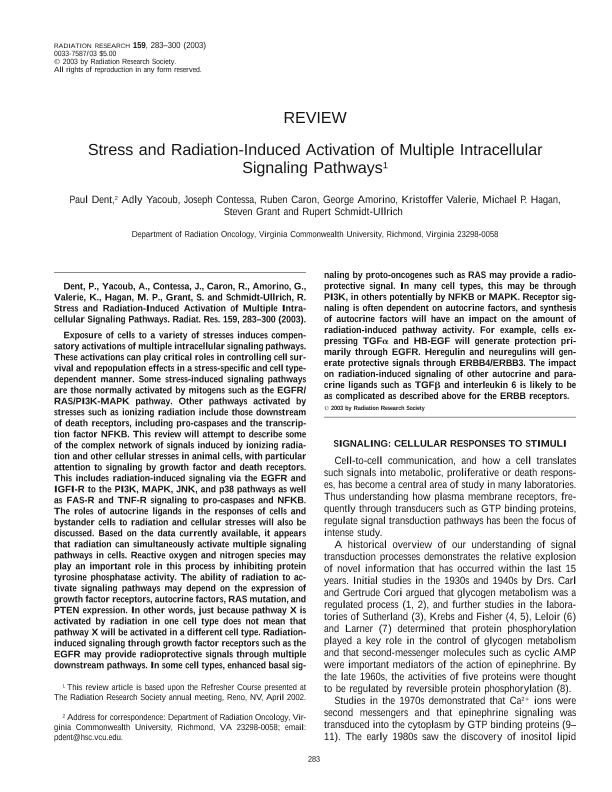Mostrar el registro sencillo del ítem
dc.contributor.author
Dent, Paul
dc.contributor.author
Yacoub, Adly
dc.contributor.author
Contessa, Joseph
dc.contributor.author
Caron, Ruben Walter

dc.contributor.author
Amorino, Geroge
dc.contributor.author
Valerie, Kristoffer
dc.contributor.author
Hagan, Michael P.
dc.contributor.author
Grant, Steven
dc.contributor.author
Schmidt Ullrich, Rupert
dc.date.available
2021-03-12T15:44:14Z
dc.date.issued
2003-03
dc.identifier.citation
Dent, Paul; Yacoub, Adly; Contessa, Joseph; Caron, Ruben Walter; Amorino, Geroge; et al.; Stress and Radiation-Induced Activation of Multiple Intracellular Signaling Pathways; Radiation Research Society; Radiation Research; 159; 3; 3-2003; 283-300
dc.identifier.issn
0033-7587
dc.identifier.uri
http://hdl.handle.net/11336/128233
dc.description.abstract
Exposure of cells to a variety of stresses induces compensatory activations of multiple intracellular signaling pathways. These activations can play critical roles in controlling cell survival and repopulation effects in a stress-specific and cell type-dependent manner. Some stress-induced signaling pathways are those normally activated by mitogens such as the EGFR/RAS/PI3K-MAPK pathway. Other pathways activated by stresses such as ionizing radiation include those downstream of death receptors, including pro-caspases and the transcription factor NFKB. This review will attempt to describe some of the complex network of signals induced by ionizing radiation and other cellular stresses in animal cells, with particular attention to signaling by growth factor and death receptors. This includes radiation-induced signaling via the EGFR and IGFI-R to the PI3K, MAPK, JNK, and p38 pathways as well as FAS-R and TNF-R signaling to pro-caspases and NFKB. The roles of autocrine ligands in the responses of cells and bystander cells to radiation and cellular stresses will also be discussed. Based on the data currently available, it appears that radiation can simultaneously activate multiple signaling pathways in cells. Reactive oxygen and nitrogen species may play an important role in this process by inhibiting protein tyrosine phosphatase activity. The ability of radiation to activate signaling pathways may depend on the expression of growth factor receptors, autocrine factors, RAS mutation, and PTEN expression. In other words, just because pathway X is activated by radiation in one cell type does not mean that pathway X will be activated in a different cell type. Radiation-induced signaling through growth factor receptors such as the EGFR may provide radioprotective signals through multiple downstream pathways. In some cell types, enhanced basal signaling by proto-oncogenes such as RAS may provide a radioprotective signal. In many cell types, this may be through PI3K, in others potentially by NFKB or MAPK. Receptor signaling is often dependent on autocrine factors, and synthesis of autocrine factors will have an impact on the amount of radiation-induced pathway activity. For example, cells expressing TGFalpha and HB-EGF will generate protection primarily through EGFR. Heregulin and neuregulins will generate protective signals through ERBB4/ERBB3. The impact on radiation-induced signaling of other autocrine and paracrine ligands such as TGFbeta and interleukin 6 is likely to be as complicated as described above for the ERBB receptors.
dc.format
application/pdf
dc.language.iso
eng
dc.publisher
Radiation Research Society
dc.rights
info:eu-repo/semantics/openAccess
dc.rights.uri
https://creativecommons.org/licenses/by-nc-sa/2.5/ar/
dc.subject
EGFR
dc.subject
PTEN
dc.subject
Stress-induced signaling pathways
dc.subject.classification
Otras Ciencias Médicas

dc.subject.classification
Otras Ciencias Médicas

dc.subject.classification
CIENCIAS MÉDICAS Y DE LA SALUD

dc.title
Stress and Radiation-Induced Activation of Multiple Intracellular Signaling Pathways
dc.type
info:eu-repo/semantics/article
dc.type
info:ar-repo/semantics/artículo
dc.type
info:eu-repo/semantics/publishedVersion
dc.date.updated
2021-01-18T15:48:26Z
dc.journal.volume
159
dc.journal.number
3
dc.journal.pagination
283-300
dc.journal.pais
Estados Unidos

dc.journal.ciudad
Lawrence
dc.description.fil
Fil: Dent, Paul. Virginia Commonwealth University; Estados Unidos
dc.description.fil
Fil: Yacoub, Adly. Virginia Commonwealth University; Estados Unidos
dc.description.fil
Fil: Contessa, Joseph. Virginia Commonwealth University; Estados Unidos
dc.description.fil
Fil: Caron, Ruben Walter. Virginia Commonwealth University; Estados Unidos. Consejo Nacional de Investigaciones Científicas y Técnicas. Centro Científico Tecnológico Conicet - Mendoza. Instituto de Medicina y Biología Experimental de Cuyo; Argentina
dc.description.fil
Fil: Amorino, Geroge. Virginia Commonwealth University; Estados Unidos
dc.description.fil
Fil: Valerie, Kristoffer. Virginia Commonwealth University; Estados Unidos
dc.description.fil
Fil: Hagan, Michael P.. Virginia Commonwealth University; Estados Unidos
dc.description.fil
Fil: Grant, Steven. Virginia Commonwealth University; Estados Unidos
dc.description.fil
Fil: Schmidt Ullrich, Rupert. Virginia Commonwealth University; Estados Unidos
dc.journal.title
Radiation Research

dc.relation.alternativeid
info:eu-repo/semantics/altIdentifier/doi/https://doi.org/10.1667/0033-7587(2003)159[0283:sariao]2.0.co;2
dc.relation.alternativeid
info:eu-repo/semantics/altIdentifier/url/https://bioone.org/journals/radiation-research/volume-159/issue-3/0033-7587(2003)159%5b0283%3aSARIAO%5d2.0.CO%3b2/Stress-and-Radiation-Induced-Activation-of-Multiple-Intracellular-Signaling-Pathways1/10.1667/0033-7587(2003)159[0283:SARIAO]2.0.CO;2.short
Archivos asociados
